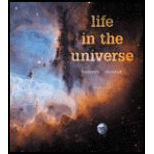
Life in the Universe (4th Edition)
4th Edition
ISBN: 9780134089089
Author: Jeffrey O. Bennett, Seth Shostak
Publisher: PEARSON
expand_more
expand_more
format_list_bulleted
Concept explainers
Question
Chapter 11, Problem 20RQ
To determine
The characteristics of regions of stars of H-R diagram.
Expert Solution & Answer
Want to see the full answer?
Check out a sample textbook solution
Students have asked these similar questions
Concept Simulation 26.4 provides the option of exploring the ray diagram that applies to this
problem. The distance between an object and its image formed by a diverging lens is 5.90 cm.
The focal length of the lens is -2.60 cm. Find (a) the image distance and (b) the object distance.
Pls help ASAP
Pls help ASAP
Chapter 11 Solutions
Life in the Universe (4th Edition)
Ch. 11 - Prob. 1RQCh. 11 - Prob. 2RQCh. 11 - Prob. 3RQCh. 11 - How do habitable zones differ among stars of...Ch. 11 - Briefly describe the conditions under which...Ch. 11 - Why are extrasolar planets hard to detect...Ch. 11 - Briefly describe the astrometric, Doppler, and...Ch. 11 - Briefly summarize the planetary properties we can...Ch. 11 - Why does the Doppler method generally allow us to...Ch. 11 - How does the transit method tell us planetary...
Ch. 11 - How do the orbits of known extrasolar planets...Ch. 11 - Summarize the key features shown in Figure 11.20,...Ch. 11 - According to current statistics, how common arc...Ch. 11 - What types of worlds seem most likely to support...Ch. 11 - How might a stars habitable zone be wider than we...Ch. 11 - How might future imagery and spectroscopy allow us...Ch. 11 - Prob. 17RQCh. 11 - Prob. 18RQCh. 11 - What is the HertzsprungRussell diagram? How does a...Ch. 11 - Prob. 20RQCh. 11 - Date: February 16, 2025. Headline: Astronomers...Ch. 11 - Prob. 22TYUCh. 11 - Date: June 19, 2028. Headline: Spectrum Reveals...Ch. 11 - Date: November 7, 2020. Headline: New Images Show...Ch. 11 - Date: November 7, 2050. Headline: New Images Show...Ch. 11 - Date: July 20, 2020. Headline: Giant Planet Found...Ch. 11 - Date: September 15, 2045. Headline: Sun-Like Star...Ch. 11 - Prob. 28TYUCh. 11 - Date: December 13, 2033. Headline: Orphan Planet...Ch. 11 - Prob. 30TYUCh. 11 - Prob. 31TYUCh. 11 - Prob. 32TYUCh. 11 - Which method could detect a planet in an orbit...Ch. 11 - To determine a planets average density, we can use...Ch. 11 - Based on the model types shown in Figure 11.20, a...Ch. 11 - According to current statistics, about what...Ch. 11 - The term super-Earth means a planet that is (a)...Ch. 11 - Our best hope for determining that life exists on...Ch. 11 - Jupiter has had an important effect on life on...Ch. 11 - Prob. 40TYUCh. 11 - Prob. 41POSCh. 11 - Unanswered Questions. As discussed in this...Ch. 11 - Explaining the Doppler Method. Explain how the...Ch. 11 - Explaining the Transit Method. Explain how the...Ch. 11 - Comparing Methods. What are the strengths and...Ch. 11 - Super-Earth. Youve discovered a super-Earth...Ch. 11 - Stars with Habitable Planets. Based on what youve...Ch. 11 - Are Earth-Like Planets Common? Based on what you...Ch. 11 - Prob. 50IFCh. 11 - Science Fiction Planet. Choose one fictional...Ch. 11 - Number of Stars with Habitable Planets. Assume...Ch. 11 - Prob. 54IFCh. 11 - Finding Orbit Sizes. The Doppler method allows us...Ch. 11 - Finding a Planetary Mass. Using the Doppler...Ch. 11 - Transit of TrES-1. The planet TrES-1, orbiting a...Ch. 11 - The Doppler Formula. The amount of Doppler shift...Ch. 11 - Prob. 59IFCh. 11 - Future Mission. Imagine that a wealthy benefactor...Ch. 11 - Is It Worth It? Thanks to rapidly advancing...Ch. 11 - Prob. 62IFCh. 11 - Extrasolar Planet Mission. Learn about a proposed...
Knowledge Booster
Learn more about
Need a deep-dive on the concept behind this application? Look no further. Learn more about this topic, physics and related others by exploring similar questions and additional content below.Similar questions
arrow_back_ios
SEE MORE QUESTIONS
arrow_forward_ios
Recommended textbooks for you
 Foundations of Astronomy (MindTap Course List)PhysicsISBN:9781337399920Author:Michael A. Seeds, Dana BackmanPublisher:Cengage Learning
Foundations of Astronomy (MindTap Course List)PhysicsISBN:9781337399920Author:Michael A. Seeds, Dana BackmanPublisher:Cengage Learning
 AstronomyPhysicsISBN:9781938168284Author:Andrew Fraknoi; David Morrison; Sidney C. WolffPublisher:OpenStax
AstronomyPhysicsISBN:9781938168284Author:Andrew Fraknoi; David Morrison; Sidney C. WolffPublisher:OpenStax Stars and Galaxies (MindTap Course List)PhysicsISBN:9781337399944Author:Michael A. SeedsPublisher:Cengage Learning
Stars and Galaxies (MindTap Course List)PhysicsISBN:9781337399944Author:Michael A. SeedsPublisher:Cengage Learning Stars and GalaxiesPhysicsISBN:9781305120785Author:Michael A. Seeds, Dana BackmanPublisher:Cengage Learning
Stars and GalaxiesPhysicsISBN:9781305120785Author:Michael A. Seeds, Dana BackmanPublisher:Cengage Learning Horizons: Exploring the Universe (MindTap Course ...PhysicsISBN:9781305960961Author:Michael A. Seeds, Dana BackmanPublisher:Cengage Learning
Horizons: Exploring the Universe (MindTap Course ...PhysicsISBN:9781305960961Author:Michael A. Seeds, Dana BackmanPublisher:Cengage Learning

Foundations of Astronomy (MindTap Course List)
Physics
ISBN:9781337399920
Author:Michael A. Seeds, Dana Backman
Publisher:Cengage Learning


Astronomy
Physics
ISBN:9781938168284
Author:Andrew Fraknoi; David Morrison; Sidney C. Wolff
Publisher:OpenStax

Stars and Galaxies (MindTap Course List)
Physics
ISBN:9781337399944
Author:Michael A. Seeds
Publisher:Cengage Learning

Stars and Galaxies
Physics
ISBN:9781305120785
Author:Michael A. Seeds, Dana Backman
Publisher:Cengage Learning

Horizons: Exploring the Universe (MindTap Course ...
Physics
ISBN:9781305960961
Author:Michael A. Seeds, Dana Backman
Publisher:Cengage Learning